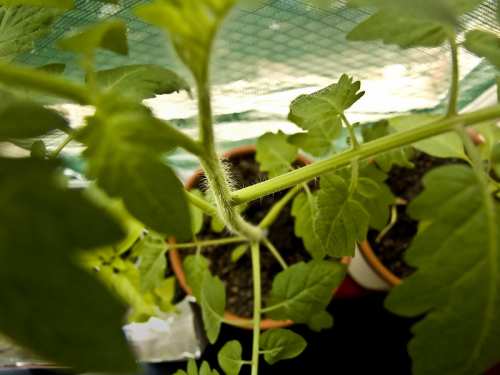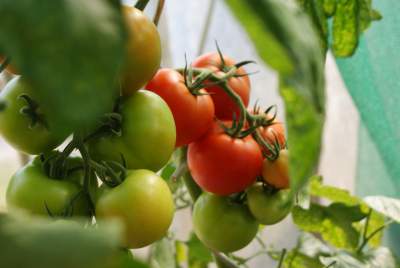Tomato plants may become too tall and leggy for a variety of reasons, but the most common cause is a lack of sunlight.
Tomatoes require full sun (at least 6-8 hours of direct sunlight per day), otherwise they can become ‘stretched’ in an attempt to reach more light.
If your tomato plants are in partial shade or not getting enough sunlight, try moving them to a sunnier spot in the garden.
Additionally, over-fertilizing with nitrogen can make tomato plants grow too tall and leggy as it encourages rapid foliage growth at the expense of fruit production. Try reducing or eliminating fertilizer applications until the plant produces fruit.
Why Are My Tomato Plants Too Tall and Leggy?

#1. Lack of sunlight
When tomato plants lack adequate sunlight, they will attempt to reach for more light by growing too tall and leggy.
Tomato plants require full sun (at least 6-8 hours of direct sunlight per day) in order to thrive and produce the best quality fruits.
If only partial sun is available, then tomato plants will become ‘stretched’ as they attempt to reach out for needed sunlight.
These plants will have weak stems that are unable to support their own weight and may also display an overall unhealthy appearance.
Without enough light, the foliage of a tomato plant will become thin and sparse, with fewer blooms or flowers than usual.
Overall growth may be stunted and fruit production reduced.
To avoid this problem, make sure to provide your tomato plants with the right amount of natural sunlight every day.
#2. Over-fertilizing with nitrogen
Over-fertilizing with nitrogen can cause tomato plants to become too tall and leggy.
Nitrogen is a vital nutrient for plant growth and development, however too much of it can be detrimental.
Too much nitrogen causes rapid foliage growth at the expense of flower and fruit production, resulting in tall and leggy plants.
The excess nitrogen encourages the plant to focus on foliage growth instead of producing fruits and flowers, leading to weakened stems that may not be able to support their own weight without additional support.
The symptoms of over-fertilizing with nitrogen include yellowing leaves, poor root development, poor flower set, low yields of fruit, stretched growth habit (leggy plants), and weak stems.
To prevent this from happening, try using a balanced fertilizer formula or reducing the amount of fertilizer applied to the tomato plants.
It’s also important to avoid top dressing or side dressing your plants with fertilizers as these contain higher concentrations of nitrogen than what is needed for optimal growth.
Additionally, make sure to apply only enough fertilizer so that the majority is absorbed by the soil rather than left on top which could burn or damage your tomato plants.
#3. Poor soil quality
Poor quality soil is typically lacking in essential nutrients and organic matter, which are necessary for the healthy growth of tomatoes.
If the soil is depleted of these important components, then it will be unable to provide adequate nutrition to the plant, resulting in weak and leggy growth.
In addition, poor soil quality can cause poor drainage and water retention, leading to over-watering or under-watering of the tomato plants which can further exacerbate the problem.
#4. Too much water
Too much watering can cause tomato plants to become tall and leggy.
When tomato plants are overwatered, their root system becomes overloaded and cannot absorb the excess moisture.
As a result, the plant will attempt to reach for more light by growing too tall and thin in an effort to find the oxygen and nutrients it needs for survival.
Additionally, moist soil can also encourage the growth of fungal diseases that can weaken and damage tomato plants, resulting in stunted growth or even death.
Overwatering can also cause nutrient deficiency in tomato plants as excessive moisture can dilute the essential minerals in the soil.
This is because water flushes out important nutrients like nitrogen, phosphorus and potassium, leaving the plant without an adequate nutrient source.
Without these essential nutrients, tomatoes will not be able to grow properly leading to weak stems that cannot support themselves.
This can make them susceptible to collapse or damage due to wind or other environmental factors.
Furthermore, overwatering may cause too much foliage growth at the expense of fruit production which leads to leggy plants with fewer blooms or flowers than usual.
Also Read: Is Chicken Manure Good for Tomato Plants?
5. Insufficient pruning or staking
Not pruning or staking tomato plants can cause them to become too tall and leggy.
Pruning or staking not only helps to direct the plant’s energy into producing more flowers and fruits, but it also helps to keep the plant upright and prevents it from becoming top heavy and falling over.
When tomato plants are allowed to grow unchecked, they tend to become too tall and thin as they reach for more light.
This can result in weak stems that cannot support their own weight and may even break off or cause the plant to collapse under its own weight.
Check this out: Should I Cut Off Yellow Leaves on Tomato Plants?
How to stop tomato plants growing too tall?
It is important to take the necessary steps to prevent tomato plants from growing too tall and spindly, known as legginess.
The most effective way of achieving this is by pruning the plant regularly.
Pruning will encourage bushier growth and discourage the plant from continuing to grow upwards.
To prune a tomato plant, pinch off any stems that have grown beyond six inches in length.
The pinched off section should be between two sets of leaves. Additionally, pruning off any side shoots or suckers that appear below the main stem can help keep your tomato plants healthy and compact.
Another useful technique for controlling height is staking or trellising tomatoes as they grow; this encourages vertical rather than horizontal growth.
When done correctly, staking or trellising can provide a tomato plant with increased support and allow for better air circulation.
Finally, providing adequate amounts of light is essential for keeping tomato plants from becoming leggy.
Tomato seedlings should be exposed to at least 6 hours of sunlight a day. If the seedlings are not getting enough light, they will stretch towards the source in an effort to find more.
To prevent this, it’s important to move them into brighter spots as soon as possible.
Also Read: Why Tomato Branches Curling Down
Can you trim the height of tomato plants?
Yes, you can trim the height of tomato plants by pruning. Pruning helps remove excess growth and encourages bushy, healthy plants that produce more tomatoes.
To prune a tall tomato plant, start at the top and look for any spindly growth or leaves that are misdirected.
Carefully snip off the stems with sharp scissors or garden clippers as close to the main stem as possible. Be careful not to damage nearby foliage while pruning.
How do you keep tomatoes short and Bushy?
In addition to pruning, there are a few other ways to help keep tomato plants short and bushy.
Planting in well-draining soil with plenty of organic matter can help provide the root system with adequate nutrition for healthier growth.
Staking or tying the plant as it grows is also important for providing stability and support that reduces potential damage from strong winds or heavy fruit production.
Pruning off any leaves that touch the ground will also discourage disease, while mulching around the base of the plant can ensure proper water drainage and reduce weed competition.
Finally, regular fertilizing throughout the season helps encourage healthy development by providing essential nutrients like nitrogen and potassium which aid in photosynthesis, leaf development and flowering.
With these simple steps, you can ensure that your tomato plants stay short and bushy, producing many delicious fruits!
What can you do with leggy tomato plants?
Leggy tomato plants are not ideal for fruiting, as they may produce fewer tomatoes than their shorter counterparts.
However, there are a few things you can do to make the most of these tall plants.
First, prune off any excess growth at the top to reduce the overall height and encourage branching further down.
You can also use stakes or cages to provide support while the plant is still growing so it doesn’t succumb to heavy winds or fruit production.
Finally, you can cut off some of the side branches from leggy tomato plants and use them for propagation in order to grow more plants from cuttings.
Tomato plant Care tips
- Plant in well-draining soil with plenty of organic matter.
- Stake or tie the plants as they grow for stability and support.
- Prune off any leaves that touch the ground for disease prevention.
- Mulch around the base of the plant for proper water drainage and weed control.
- Regularly fertilize with essential nutrients like nitrogen and potassium to promote healthy growth and flowering.
- Prune tall tomato plants from the top, removing up to two-thirds of their total height when necessary.
- Cut off side branches from leggy tomato plants to use for propagation if desired.
- Provide adequate sunlight and water to keep your tomato plants thriving throughout the season!
- Inspect plants regularly for signs of disease or pest infestations, and take action as needed to protect your crops.
- Use neem oil to get rid of aphids from tomato plant. It has pesticide and fungicide abilities to deter pests.
Read these articles:
- How to Turn Green Tomatoes Red in the Fall?
- Why Are My Tomato Flowers Falling Off?
- How Deep Should a Raised Bed Be for Tomatoes?
Conclusion
Tomato plants that become too tall and leggy can be trimmed to reduce their height and discouraged from growing further.
Pruning, staking or tying the plant, removing leaves that touch the ground, mulching around the base of the plant, and regular fertilizing can help keep tomato plants short and bushy for a better harvest.
Additionally, leggy tomato plants can still be used for propagation in order to grow more plants from cuttings.

